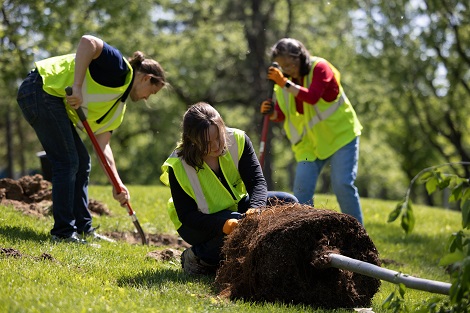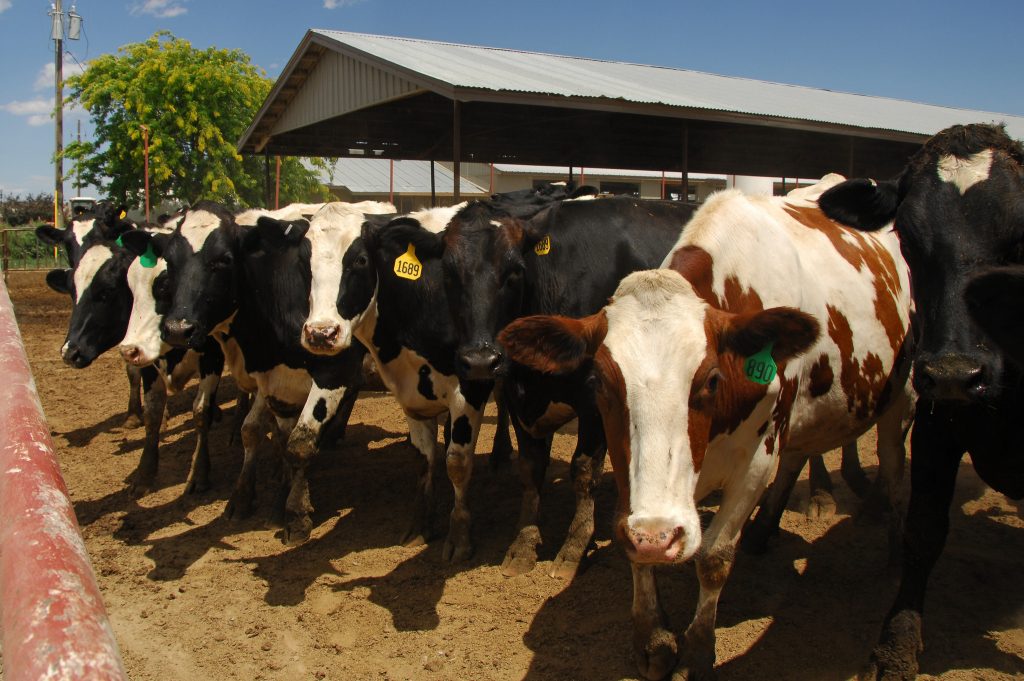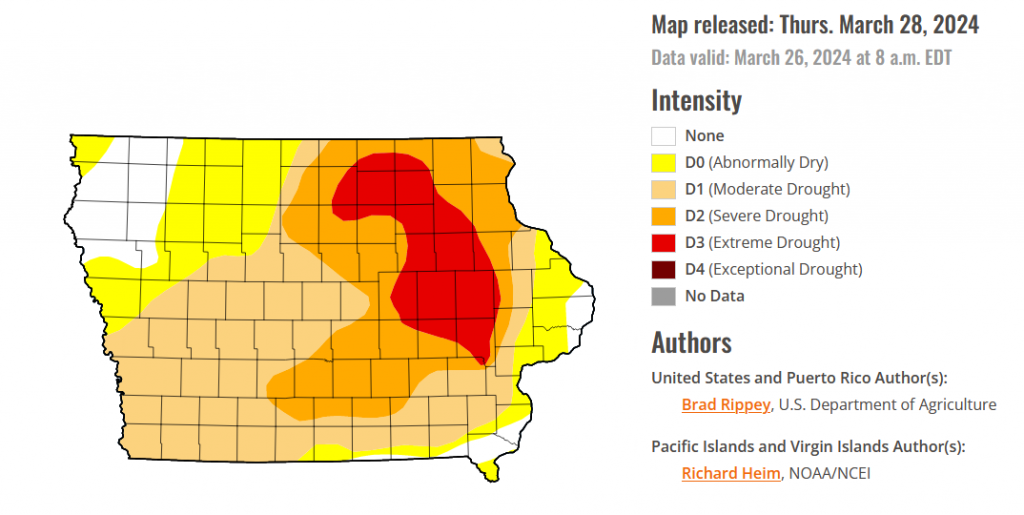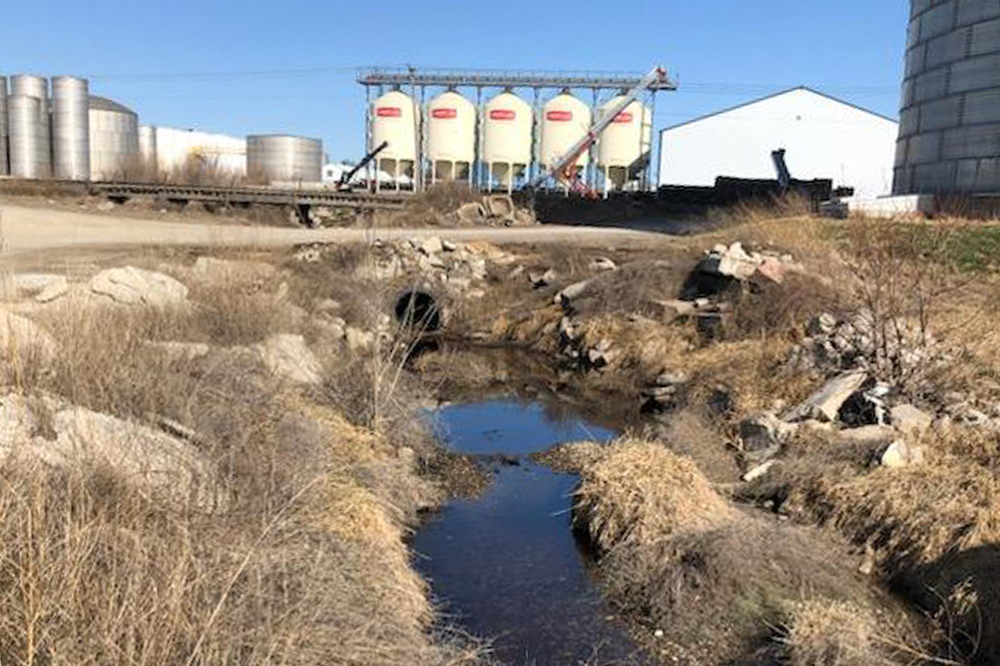CLICK HERE for the latest market quotes from the Iowa Agribusiness Network!
CLICK HERE for the latest market quotes from the Brownfield Ag News Network!
CLICK HERE for the latest market quotes from the Iowa Agribusiness Network!
CLICK HERE for the latest market quotes from the Brownfield Ag News Network!
Palo Alto County, Iowa —[KCCI] – An insect that kills ash trees has been confirmed in all but one of Iowa’s 99 counties. According to the Iowa Department of Agriculture, the Emerald Ash Borer was confirmed in Palo Alto County last month. The non-native, wood-boring insect kills ash trees by laying eggs inside the wood, according to the Department of Ag. The dead trees then pose the risk of property damage or personal injury if they fall. The Emerald Ash Borer was first found in Iowa in 2010 and has slowly made its way across the state.
In July 2014, the city of Des Moines announced that roughly 13,000 ash trees along city streets would need to be treated or removed. Just two years ago, there were still six counties without a confirmed case of the destructive insect. That list is now whittled down to one. Emmet County, which sits just north of Palo Alto County, along the border with Minnesota, is the only county that hasn’t reported the pest’s presence. The Iowa Department of Agriculture and Land Stewardship notes that while the insect travels only short distances on its own, it uses people to aid its long-distance movement — often in infested firewood. More information on the Emerald Ash Borer can be found at iowatreepests.com.
CEDAR RAPIDS, Iowa – Alliant Energy has named 41 Iowa communities, including the City of Atlantic and Creston FFA, as recipients of grants totaling nearly $145,000 through the company’s Community Tree Planting program, part of its One Million Trees initiative. Alliant Energy partners with Trees Forever to help communities develop, select and plant a diverse mix of trees. A tree expert helps communities select the best species for their areas and create care and maintenance plans to ensure the new trees have long, healthy lives.
Atlantic receives a $3,000 grant for community tree planting at the local campground next to camp sites. Local students will volunteer this spring. The Creston FFA Chapter will receive a grant for $4,950, for community tree planting led by the local FFA chapter. Locations will be on city property and school locations. 
Since 1990, Trees Forever and Alliant Energy have awarded over $7.85 million in grants and planted more than 1.1 million trees through their partnership and programs in Iowa and Wisconsin. Across Iowa, communities are eligible to apply for grants up to $5,000 to fund new trees.
Some communities will begin to plant trees this spring while others will wait until fall.
JOHNSON COUNTY, Iowa (KCRG & USDA) – This week, the USDA announced cases of bird flu had been found in dairy cows in a few states; Texas, Kansas, and Michigan. Iowa currently isn’t one of those states, but cattle farmers are keeping a close eye it. Last year, the avian flu killed nearly 3 million birds in the state of Iowa. That ranges from commercial poultry farms to backyard flocks.
Iowa State Extension Dairy Veterinarian Phillip Jardon said cows in Texas had contracted an unknown illness, which reduced milk production in older cattle. It wasn’t until this week he said pathologists learned it was the bird flu, but they aren’t sure how it happened.
Jardon said in each of the found cases in Texas, dead birds had been found near the farm. While he said the findings are all still new and research was being done, so far, the virus doesn’t seem to be as deadly to cattle. Jardon said it would still be a good idea for farmers to be vigilant as they get closer to starting selling and moving cattle this season.
In its latest report, the USDA said ” There continues to be no concern about the safety of the commercial milk supply because products are pasteurized before entering the market, or that this circumstance poses a risk to consumer health. Dairies are required to send only milk from healthy animals into processing for human consumption; milk from impacted animals is being diverted or destroyed so that it does not enter the human food supply.
In addition, pasteurization has continually proven to inactivate bacteria and viruses, like influenza, in milk. Pasteurization is required for any milk entering interstate commerce for human consumption. FDA’s longstanding position is that unpasteurized, raw milk can harbor dangerous microorganisms that can pose serious health risks to consumers, and FDA is reminding consumers of the risks associated with raw milk consumption in light of the HPAI detections.”
(Radio Iowa) – One northeast Iowa farmer has a head start on coloring his Easter eggs. Mark Westbrock keeps between 180 to 200 chickens on his Solstice Farm in Waverly. They provide eggs that range in color from the standard shades of brown and white to spots, and even more unexpected hues. “Blue eggs, green eggs, 364 days out of the year, they’re the most beautiful eggs out there, but they don’t dye very well,” he says, “You can’t really dye them, because they’re already colored.”
Westbrock says the color comes from having unique birds.”It’s just different breeds of chicken that people have developed over the years. There are some breeds of green egg layers that have been around for a while, and then kind of more recently people have developed breeds that can lay these bright brilliant blue eggs,” he explains.
Westbrock adds that organic and sustainable farming practices also help in bringing out an egg’s richer colors. His farm has been around for a little more than five years.
OMAHA (Via the Iowa Capital Dispatch) — U.S. Agriculture Secretary Tom Vilsack has announced $124 million in grants and loans to projects in 44 states, including Iowa, that are aimed at saving energy and creating more income streams for smaller farmers and rural businesses. The heftiest award — nearly $4 million — went to Nebraska-based Bluestem Systems to help boost a creative process that removes water and pathogens from manure. In doing so, the company produces dry fertilizer and recycles the water for on-site use. Russ Vering, owner of Bluestem Systems, based in Howells, Nebraska, was on the panel. He said the nearly $4 million FPEP award headed to his business will help construction and equipment purchases at two Nebraska locations and another in Iowa.
In all, Vilsack said, the 542 projects — most of the awards range from about $7,000 to $1 million — are expected to advance President Joe Biden’s pledge to expand clean energy and allow small- to mid-sized farm and rural operations a better chance at competing with larger counterparts. Thirty Iowa projects received a total of just over $2.76 million.
Speaking to a group of about 75 people at the University of Nebraska at Omaha, Vilsack described key challenges faced by most farmers. Since 1981, he said, the nation has lost some 545,000 farms and 155 million acres of former farmland. While the nation has enjoyed record farm income in the last few years, he said, the income has been concentrated among about 7% of s farms that cumulatively collect up to 89% of the bounty. Part of the answer to shrinking rural communities, Vilsack said, is to provide access to funding via programs such as REAP and FPEP. Such monies, he said, open the door to creating other “value-added” opportunities and sources of income for farmers. Instead of “get big or get out,” Vilsack said: “The word is entrepreneurial.”

U.S. Secretary of Agriculture Tom Vilsack, in Omaha on March 28, 2024, announced about $124 million in grant and loans to smaller farms and rural businesses across the country, including 30 in Iowa. (Photo by Cindy Gonzalez/Nebraska Examiner) via Iowa Capital Dispatch
Of the newly announced grants and loans, Vilsack said the investments he announced “Will expand access to renewable energy systems and domestic fertilizer, all while creating good-paying jobs and saving people money that they can then invest back into their businesses and communities.
Among the larger REAP awards for Iowa projects were:
Among the larger Iowa recipients were:
(Radio Iowa) – The Iowa House has voted to let landowners seek a court ruling now on whether carbon pipeline developers qualify for the government’s eminent domain authority to force unwilling property owners to let the pipeline on their land. Republican Representative Charley Thomson of Charles City led debate on the proposal.
“We’re faced with lots of choices in this body. Few go to the heart of Iowa the way this does. Land is the original asset in Iowa. It’s in our souls. An unjust taking of land without remedy is not only irritating, it’s outrageous,” Thomson said. “Let’s give Iowans a remedy.” Thomson says, right now, property owners are forced to live in limbo for years — waiting for the Iowa Utilities Board decision on the project as well as the resolution of lawsuits expected to challenge that decision.
“That means for that entire period you have these Century Farms, landowners, people who didn’t especially want to have this pipeline going over their land and have some questions about it, not being able to get an answer on their constitutional law question,” Thomson says, “and not being able to sell their land at full value or make a decision on tiling or make a decision on estate planning.”
Republican Representative Steven Holt of Denison says Iowa landowners are pleading with elected officials to do the right thing — while their land is in limbo. “For several years I’ve watched, I’ve listened and I’ve been deeply concerned,” Holt says. “I’ve watched landowners fighting to protect their private property rights…and I have been disturbed by that fact that others do not hear their pleas or the truth of their message.”
Representative Bobby Kaufmann, a Republican from Wilton, was the other lawmaker who spoke before the bill passed on an 86 to seven vote — and Kaufmann sounded as if he was speaking directly to Bruce Rastetter, an influential G-O-P donor who owns Summit Carbon Solutions.
“Most importantly I have a message for those who would choose to attempt to use their money to influence this vote, for those who would attempt to use their money to prevent this vote,” Kaufmann says. “My message is: ‘Take your money and shove it!'” Kaufmann says government doesn’t exist to make the confiscation of private property easier or cheaper for pipeline developers.
The Iowa House has previously passed other proposals to set up pipeline regulations, but all have stalled in the Iowa Senate.
(Radio Iowa) – The recent snow and rains have helped push back some of the drought conditions in the state. D-N-R Hydrologist, Tim Hall, the rainfall has been good to see. “The statewide average over the last seven days, three times the normal rainfall for that seven day period. And for the month of March, we’re ahead of normal. And so those things are all reflected in the U-S Drought Monitor this week,” Hall says. Northeast Iowa remains the driest area of the state, but the picture is better than last week.
“Almost 20 percent of the state was designated as D-3 extreme drought. And now that’s down to 12 percent,” he says. Hall says it is good to see the dry weather turnaround in March. “Every month that goes by between March and April in May and June, the monthly precipitation averages go up. So that’s why it’s really critical when we get above normal rainfall in March, because March is a pretty wet month, and even more so for April and even more so for May,” Halls says. He says the past few years a promising start to spring didn’t pan out. 
“We’ve seen really encouraging early spring and late winter rainfalls, but then the tap has been shut off. And we’ve missed out on April May and June rainfalls over the past few years,” he says. “So we’re really hoping that this will set a trend that will allow us to see above normal rainfall in April and then May and then June. And that’ll go a long ways toward getting some significant areas of drought wiped off the map here.”
The Drought Monitor shows the areas of the state not reporting any drought have gone from just more than two percent to now just under ten percent.
RED OAK – The fertilizer spill near Red Oak in Montgomery County earlier this month killed nearly all the fish in an almost 50-mile stretch of the East Nishnabotna River to the Missouri border.
On March 11, NEW Cooperative, Inc. in Red Oak notified the Iowa Department of Natural Resources (DNR) of a release occurring on-site. Approximately 1,500 tons (265,000 gallons) of liquid nitrogen fertilizer (32% solution) discharged into a drainage ditch, then into the East Nishnabotna River. The release occurred due to an aboveground storage tank valve left open for the weekend.
Upon learning of the release, DNR staff from the Environmental Field Office worked with the NEW Cooperative staff to stop the release and began cleanup efforts. DNR Fisheries staff began investigating the impacts to the Nishnabotna River.
DNR Fisheries staff documented the fish kill occurring in all 49.8 miles of the East Nishnabotna and Nishnabotna Rivers downstream of the spill. The kill continued in Missouri’s portion of the Nishnabotna River and ended near the confluence with the Missouri River.
DNR Fisheries staff used methods outlined in American Fisheries Society, Special Publication 35, and 571 Iowa Administrative Code Chapter 113 to evaluate the extent of the fish kill and estimate the number of dead fish. The rules and the use of the American Fisheries Society’s methodology are authorized by Iowa Code section 481A.151.
The fish kill count as of March 28th is below. Investigations of the release’s impact to other aquatic life are ongoing.
| Species | Number of Fish |
| Minnow Shiner Dace Chub | 707,871 |
| Suckers | 1,542 |
| Goldeye | 201 |
| Common Carp | 9,255 |
| Carpsucker | 14,500 |
| Buffalo | 4 |
| Sauger | 199 |
| Channel Catfish | 7,681 |
| Flathead Catfish | 264 |
| Green Sunfish | 935 |
| Silver Carp | 67 |
| Largemouth Bass | 69 |
| Grass Carp, diploid | 6,654 |
| Total | 749,242 |
Cleanup efforts at the NEW Cooperative facility are ongoing. Contaminated soils continue to be removed from the facility and from around a levee west of the facility. The contaminated soils will be land applied at approved locations, at agronomic rates consistent with Iowa law. Additionally, NEW Cooperative is pumping water from the east side of the levee. The pumped water will be stored in on-site holding tanks until land application can occur. A third-party consultant is collecting samples of the water-fertilizer mixture to determine accurate land application rates.
Per Iowa Code section 455B.186, a pollutant cannot be discharged into a river without a permit. DNR field staff are working with the DNR’s Legal Services Bureau to determine next steps with regards to enforcement action and restitution for lost aquatic life. The DNR will continue to monitor cleanup efforts.
Field test results indicate ammonia levels are declining in the river. The DNR continues to advise people to avoid recreating on the river and collecting and/or eating dead fish found on or near the river.
(Iowa New Service) – A farm group is helping Iowa agriculture producers find ways to reduce the amount of nitrogen they use on their crops. Excess nitrates can wind up in ground and surface water, and cause health problems. Practical Farmers of Iowa is encouraging farmers to find just the right amount of nitrogen they need for their crops – while avoiding applying too much, which the group says is common.
PFI’s Field Crops Viability Coordinator – Chelsea Ferrie – said thanks to federal grants and private funding, the group will pay farmers up to $35 for every acre that has a lower than normal yield if they didn’t apply enough nitrogen. “No cost to the farmer, either,” said Ferrie. “We’re trying to help incentivize them. This is something that farmers want to do – I mean, they want to be good stewards of the land – but also, that they need to have a profitable farm.”
The application period for the program is open through the end of April. To help them reach the right nitrogen balance, Ferrie said PFI will help farmers on the front end of the process, too – so they aren’t left guessing how much to apply. “Talk through what your typical fertilizer plan is, and what your reduction plan would be,” said Ferrie. “Then you would implement this year, going into the spring and into the season.”
Farmers have relied on nitrogen-based fertilizers for generations – but when applied in excess, nitrates run off into ground and surface water, posing health concerns for animals and people.
(Iowa Capital Dispatch) – A fertilizer spill this month in southwest Iowa killed nearly all the fish in a 60-mile stretch of river with an estimated death toll of more than 750,000, according to Iowa and Missouri conservation officers. That is the biggest fish kill in Iowa in at least a decade and the fifth-largest on record, according to state data. And it could have been worse: Fish populations were likely smaller than normal when the spill happened because of cold water temperatures and low river flows.
The spill originated at NEW Cooperative in Red Oak, where a valve that either malfunctioned or was not properly closed leaked about 265,000 gallons of liquid nitrogen fertilizer, most of which went into the nearby East Nishnabotna River. The leak happened on a weekend from March 9 to 11 in an area where the fertilizer is distributed to customers of the farmers’ co-op. That area is not required by state rules to have barriers that would prevent a leak from reaching the river. The result was a widespread annihilation of aquatic life.
A DNR investigation found dead or dying fish for 50 miles of river — beyond where the East and West Nishnabotnas meet — all the way to the Missouri border. There were also numerous dead frogs, snakes, mussels and earthworms. The DNR will return in late spring to note whether the fertilizer killed turtles that had buried themselves in the river bottom for winter. Their bloated carcasses will float to the river surface.
The carnage continued into Missouri, where the unified Nishnabotna River flows for about 10 miles before it meets the Missouri River. Matt Combes, a science unit supervisor for the Missouri Department of Conservation, said there was “a near total fish kill” in that state. The department surveyed one bank of the river for about two miles and counted nearly 4,000 dead fish. It will use that sample to estimate the total number of fish that were killed, which will likely be in the tens of thousands. The department is continuing to monitor the Missouri and Nishnabotna rivers for additional effects from the contamination. It’s possible NEW Cooperative will face sanctions in both states.

NEW Cooperative spill
The size of the fish kill in Iowa was estimated to be about 749,000, said Chris Larson, a fisheries supervisor for the DNR. Small fish such as minnows and chubs account for the vast majority of those fish, but among them were also about 7,700 channel catfish that anglers target.
Those who are responsible for fish kills typically pay restitution to the state based on the number and types of fish that die. Larson said a total restitution amount has not yet been solidified, but that the estimated value of the small fish is about $85,000. The value of the catfish would be about $115,000. Those two figures combined would be the largest valuation for a documented Iowa fish kill, according to DNR data.
Others that have caused recent fish kills have typically paid fish restitutions and a fines of up to $10,000 — the maximum the DNR can order administratively. The department has the option to seek higher penalties in district court.